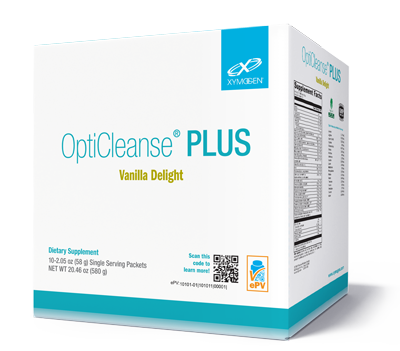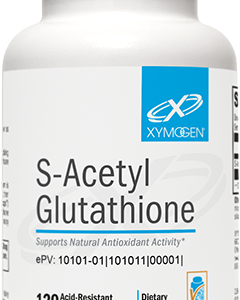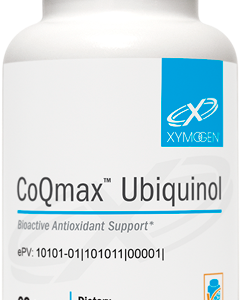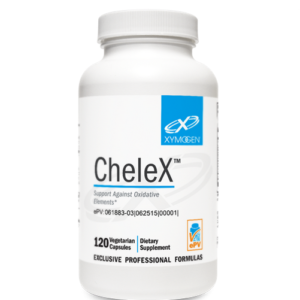Scientific Information/Data
OptiCleanse™ Plus represents an advanced, comprehensive approach to supporting the body’s detoxification processes. Provision of high-quality, easy-to-digest protein with the addition of amino acids, micronutrients, essential fatty acids, and metabolic cofactors makes OptiCleanse Plus an indispensable adjunct to an effective detoxification program.*
VegaPro™ is XYMOGEN’s proprietary blend of pea protein isolate and rice protein concentrate plus L-glutamine, L-glycine, and taurine. Generation of glutathione and sulfation cofactors necessary for phase II conjugation requires an array of amino acids. The combination of pea protein and rice protein provides a non-GMO protein source that is easily digested and achieves an amino acid score of 100% (a measure of how efficiently a protein meets the protein synthesis needs of children and adults). VegaPro does not contain milk, soy, wheat, corn, or animal-based protein.*
OptiCleanse Plus contains 24 grams of protein per serving—the equivalent of approximately three-and-a-half ounces of dietary protein derived from sources such as poultry or fish. Dietary protein is essential for building and maintaining lean body mass, hormones, and neurotransmitters. Protein is also essential for the biosynthesis of metabolically active tripeptides such as glutathione, a key factor in detoxification of exogenous and endogenous toxins. Overall proteinenergy metabolism affects phase II detoxification reactions as well as the activity of cytochrome P450 enzymes, the enzymes which detoxify environmental chemicals and drugs.*[1]
Vitamins and Minerals Adequate biotransformation depends upon the mitochondrial generation of ATP, which requires several nutrient cofactors including thiamin, riboflavin, niacin, pantothenic acid, and magnesium. Minerals such as selenium, copper, zinc, and manganese, along with vitamins A, C, and E support antioxidant mechanisms that counteract the reactive oxygen species (intermediary metabolites) that occur between phase I and phase II detoxification. N-acetyl-cysteine and alpha-lipoic acid are present to support production of glutathione, which is also provided intact in OptiCleanse Plus.*
Specific ingredients that support phase II pathways comprise the activated, readily available form of B vitamins, including 5-methyltetrahydrofolate (folate), methylcobalamin (B12), and pyridoxal 5’-phosphate (B6) for methylation; Preventium® (a patented form of potassium hydrogen d-glucarate) for glucuronidation; alphalipoic acid (for antioxidant and liver support); N-acetyl-cysteine for sulfation; and d-calcium pantothenate, pyridoxal 5’-phosphate, and magnesium for acetylation.[2-7] 5-methyltetrahydrofolate (5-MTHF) is provided as Quatrefolic®, which has greater stability, solubility, and bioavailability than calcium salt forms. Using science and patented technology, the formula’s pharmaceutical-grade inorganic minerals have been transformed into mineral amino acid chelates for enhanced absorption by the body. XYMOGEN has earned, and OptiCleanse Plus proudly bears, the Albion Gold Seal.*
MeadowPure™ provides organic, full-fat, non-GMO, milled golden flax seeds that have been selected and processed under U.S. patent. Flaxseed is found to be the most abundant source of the lignan SDG (secoisolariciresinol diglucoside). Metabolites of SDG are closely studied for their roles in supporting healthy hormone metabolism, detoxification, antioxidant mechanisms, and maintenance of normal lipid and glucose levels.[8] MeadowPure is also a source of the essential omega-3 fatty acid alpha-linolenic acid, as well as soluble fiber, vitamins, minerals, and the essential omega-6 fatty acid, linoleic acid.*
Designed for comprehensive detoxification with additional gastrointestinal support, OptiCleanse Plus also provides inulin (from non-GMO chicory), a valuable prebiotic and source of dietary fiber, as well as glutamine,[9-11] a conditionally essential amino acid.*
*These statements have not been evaluated by the Food and Drug Administration. This product is not intended to diagnose, treat, cure, or prevent any disease.
References
1. Wu G, Fang YZ, Yang S, et al. Glutathione metabolism and its implications for health. J Nutr. 2004 Mar;134(3):489-92. [PMID: 14988435]]
2. Brosnan JT, et al. Methylation demand: a key determinant of homocysteine metabolism. Acta Biochim Pol. 2004;51(2):405-13. [PMID: 15218538]
3. Levy G. Sulfate conjugation in drug metabolism: role of inorganic sulfate. Fed Proc. 1986 Jul;45(8):2235-40. [PMID: 3459670]
4. Zółtaszek R. The biological role of D-glucaric acid and its derivatives: potential use in medicine [in Polish]. Postepy Hig Med Dosw (Online). 2008 Sep 5;62:451-62. [PMID: 18772850]
5. Zamek-Gliszczynski MJ, Hoffmaster KA, Nezasa K, et al. Integration of hepatic drug transporters and phase II metabolizing enzymes: mechanisms of hepatic excretion of sulfate, glucuronide, and glutathione metabolites. Eur J Pharm Sci. 2006 Apr;27(5):447-86. [PMID: 16472997]
6. Baker SM, Bennett P, Bland JS, et al. Textbook of Functional Medicine. Gig Harbor, WA: The Institute for Functional Medicine; 2010.
7. Shils ME, Shike MS, Ross AC, et al. Modern Nutrition in Health and Disease. 10th ed. Baltimore, MD: Williams & Wilkins; 2005.
8. Adolphe JL, Whiting SJ, Juurlink BH, et al. Health effects with consumption of the flax lignan secoisolariciresinol diglucoside. Br J Nutr. 2010 Apr;103(7):929- 38. [PMID: 20003621]
9. Turczynowski W, Szczepanik AM, Garlicki J, et al. Glutamine–its metabolic role and possibilities for clinical use [in Polish]. Przegl Lek. 1998;55(12):659-62. Review. [PMID: 10354717]
10. Wang WW, Qiao SY, Li DF. Amino acids and gut function. Amino Acids. 2009 May;37(1):105-10. Review. [PMID: 18670730]
11. Wischmeyer PE. Glutamine: role in critical illness and ongoing clinical trials. Curr Opin Gastroenterol. 2008 Mar;24(2):190-7. Review. [PMID: 18301270]







Reviews
There are no reviews yet.